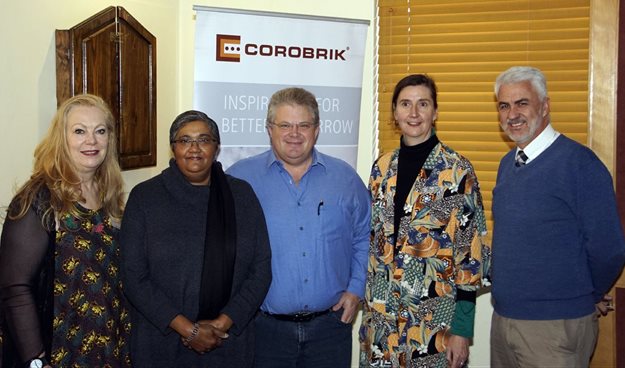Women in Architecture, in partnership with the South African Institute Architects (SAIA KZN), earlier this month hosted its 'The future is not female... It is intersectional' workshop. The event was hosted by Corobrik at its head office in Avoca, Durban.

L-R: Kate Otten, vice president of SAIA and founder of Kate Otten Architects; Karuni Naidoo, founder of the Women in Architecture workshop; Dirk Meyer, chief executive of Corobrik; Nina Saunders, programme manager, City Architecture Department, eThekwini Municipality; and SAIA-KZN president Patrick Smith
The organisers defined 'intersectionality', the theme of the workshop, as: “The way in which people’s experiences are shaped by their race, class, gender and sexuality all at the same time. It is a way of understanding how multiple forms of inequality and disadvantage can compound themselves and create obstacles often not understood within conventional ways of thinking.”
According to Karuni Naidoo, founder of the Women in Architecture workshop, “KZN continues to lead the way with robust and relevant discussions about feminism and women’s contributions to South Africa’s built environment. Through efforts of the SAIA Transformation Committee, the many and varied events around the country during Women’s Month this year indicate that the movement has taken hold around the country.”
Addressing entrenched divisions
Guest speakers were asked to dig deep into their personal and professional challenges within the field of architecture, with the collective objective of searching for the next step forward – especially when it came to breaking down the walls of entrenched mindsets which have come to establish themselves as the norm. While women in architecture have already had to work really hard while suffering gender injustice in what still seems to be a male-dominated field, it is heartening and courageous that they are having conversations around other injustices (such as race, sexuality, class, disability and religion) and looking for ways in which the divisions already in place can be addressed meaningfully.
The day’s programme unfolded with Amanda Lead and Nindya Bucktowar sharing their personal and professional architectural journeys.
Lead of Lead Architects described “the spaces in between” as being the generative force for change and improvement. Fix the heart and the rest will follow, she said, asserting that women tended to be more fluid in what they did and therefore able to heal broken spaces and discover solutions to problems within built environments such as schools and campuses and places of worship. She noted that what set women apart was their ability to engage with people.
Bucktowar, co-director of NT Design Studio which specialises in architectural, graphic and industrial design, called for a more inclusive approach to design. She observed: “You can live in a city and visit every place but you don’t know a city until you know the people.” She showcased the intricacies of her mind and handwork. The seamless movement between scales and modes of creative production spoke as much to the theme as to the greater freedoms seized by the younger and more digitally empowered.
Their journeys were followed by guest speakers Kate Otten, Queen Mjwara and Pat Horn.
Otten, vice president of SAIA and founder of Kate Otten Architects, declared that creating her own practice had been her survival strategy and brand of personal activism when it came to challenging inequality within the architectural profession. Two recent projects by Kate Otten Architects align beautifully with the notion of an “intersectionally responsive built environment” and dissolve the spatial and physical barriers that usually define the public / private interface – an antidote to what she refers to as “fear-based architecture”.
'Love-hate relationship with architects'
Mjwara, managing director of SADC Empower, shared her experience in property and asset management and shared her own challenges as a black woman when it came to fitting into a male-dominated world. Admitting to a love-hate relationship with architects, she challenged them to not work in silos but instead consult more widely with other property professionals to design spaces more suited to their uses. Queen ruffled some feathers with provocative comments about how architects do or do not serve their clients and further challenged the prevailing aesthetic of KZN architecture. “Where is KZN?” She made a strong and relevant case for women to move towards the future they wish for themselves, refraining from self-doubt, self-hate and fear.
Socialist, feminist, trade unionist and founder of StreetNet International which advocates for street vendors globally, Horn added her voice to the call for architects to negotiate with the users of spaces from the planning stage. Noting that people had the right to representation and access to public space, she told her fellow panelists that more women leaders were needed. Horn reiterated the StreetNet slogan: “Nothing for us without us” in calling for inclusion of end users at the onset of projects.
Women architects shunning the commercial space
The panel discussion which followed included inputs from audience members and amongst the issues and themes which came to the fore was that many talented women architects were shunning the commercial space because of gender discrimination that stretched from the meeting room to the site office. They also felt that it was no longer possible to add value to public sector projects such as schools and clinics with miniscule budgets. It was noted that there is an urgent need to create platforms for discussion to re-educate a client body that not only included developers and contractors, but also those holding the purse strings in both the private and public sectors. Women needed to make their voices heard and ensure that they not only engaged with a wider range of professionals on each project but also with end users who may have completely different perceptions and needs.

















